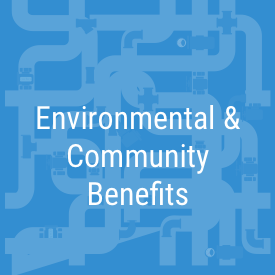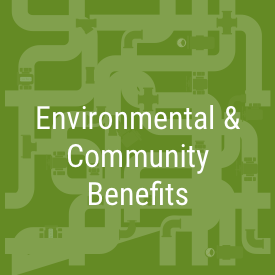The project is located in the central portion of the Coyote Watershed and extends approximately 9 miles between Montague Expressway and Tully Road in San José.
Preferred project: A federal-state-local partnership
The primary project objective is to reduce the risk of flooding to homes, schools, businesses, and highways in the Coyote Creek floodplain for floods up to the level of flooding that occurred on Feb. 21, 2017, approximately a 20 to 25-year flood event, and includes planning, design, and project construction. Alternative funding sources, including federal funding, state grants, and additional local funding sources, are being explored and will need to be secured for full construction of the project.
Local funding only project:
The local funding only option includes identifying short-term flood relief solutions that are permittable and do not exacerbate flooding elsewhere, with implementation to begin prior to the 2017-2018 winter season. In addition, under the local funding only option, Valley Water will complete the planning and design phases of the preferred project and identify prioritized elements of the project for construction with the remaining local funds.








The Coyote Creek Flood Protection Project (Project) will provide solutions to reduce the risk of flooding to Coyote Creek adjacent communities from Montague Expressway to Tully Road up to the level of the February 2017 flood, which was the highest flood event observed since Anderson Dam was constructed in 1950. The project is currently in the design phase, with staff actively gathering and evaluating critical data that will help identify the best possible project elements to reduce the community’s flood risk.
Informational Meeting
Valley Water is hosting a meeting on July 22, 2021, to update neighbors on the Coyote Creek Flood Protection Project and the Federal Energy Regulatory Commission Order Compliance Project, known as the Coyote Creek Flood Management Measures project. Both Coyote Creek projects are being coordinated with the Anderson Dam Tunnel Project and the Anderson Dam Seismic Retrofit Project timelines.
Join us virtually or in-person on July 22, 6:00 to 8:00 pm.
Virtual meeting details
WebLink: https://valleywater.zoom.us/j/85683033092
Passcode: 856 8303 3092
Call-in: 1-669-900-9128
In-person meeting details
Valley Water Headquarters (Boardroom)
5700 Almaden Expressway
San Jose, CA 95118
Past Public Meetings
The following meetings were held in June 2020 to obtain feedback on the proposed project alternatives.
|
Wednesday, June 10 |
|
|
Thursday, June 11 |
|
|
Wednesday, June 17 |
Frequently Asked Questions
Public meetings were held in May, June, and November of 2019. Questions from those meetings were combined and summarized to develop the content of this comprehensive FAQ document. Please note that many of the questions were addressed during those public presentations and video recordings of them are available to view under the reports and documents section of this webpage.
Visit our Valley Water blog to learn about our community input efforts on the Coyote Creek project.
About the Project
Below are links to the project brochure and creek improvements insert, which include a project description, timeline and actions taken to reduce flood risks along Coyote Creek.
- English: Project shell and insert
- Spanish: Project shell and insert
- Vietnamese: Project shell and insert
Valley Water completed the installation of an interim floodwall and embankment along Coyote Creek in the Rock Springs community in December 2017. This structure provides protection to the Rock Springs community from a flood event equivalent to the February 21, 2017 flood.
In addition, due to a February 2020 Federal Energy Regulatory Commission (FERC) letter ordering Valley Water to immediately implement interim risk reduction measures to protect the public from risk of dam failure at Anderson Dam due to seismic activity, some elements originally planned for the Coyote Creek Flood Protection Project were deemed to be needed for implementation sooner. As a result, the original Coyote Creek Flood Protection Project was split into two different components, the Coyote Creek Flood Management Measures for the FERC Order Compliance Project (FOCP), and the Coyote Creek Flood Protection Project.
Progress along Coyote Creek
Since the flood along Coyote Creek in February 2017, the Valley Water Board of Directors acted on a series of short-term projects to help reduce the risk of flooding along Coyote Creek. The actions varied from immediate levee repairs and vegetation removal to advocacy for state and federal funding. In addition, the board formed the Coyote Creek Ad Hoc Committee to help steer efforts to help reduce flood risks along Coyote Creek.
Since the start of the design phase in Summer 2020, Valley Water has begun coordinating with property owners and stakeholders to collect field data where proposed flood protection elements will be constructed to aid in the design of these elements. Additionally, Valley Water is in the process of hiring a design consultant.
The project update mailer is available for your review.
Updated June 2021
About the Project
Below are links to the project brochure and creek improvements insert, which include a project description, timeline and actions taken to reduce flood risks along Coyote Creek.
- English: Project shell and insert
- Spanish: Project shell and insert
- Vietnamese: Project shell and insert
Previous Public Meeting Materials
The following presentation was provided to the San Jose Parks Advocates in January 2020. The presentation is solely focused on the proposed alternatives that would be implemented at Watson, William Street, Selma Olinder, Coyote Meadows, and Kelley parks.
- SJ Parks Advocates presentation
November 13, 2019: Roosevelt Community Center
November 7, 2019: Franklin McKinley School District
November 6, 2019: Golden Wheel Mobile Home Park (Club House)
June 3, 2019 Roosevelt Community Center
- Agenda
- Presentation
- Reaches 6 and 7 Spilling Map
- Reaches 6 and 7 Conceptuals
- Facebook Live meeting video
May 30, 2019 Franklin-McKinley School District
- Agenda
- Presentation
- Reach 5 Railroad - Cross Sections Poster
- Reach 8 Spilling Map
- Reach 8 Conceptuals
- 1. History and Location
- 2. Reaches and Cross Sections
- 3. Conceptual William Street Park
- 4. Conceptual Arroyo Way #1
- 5. Conceptual Flea Market
- 6. Conceptual Arroyo Way #2
- Facebook Live meeting video
May 21, 2019 San Jose Conservation Corps
- Agenda
- Presentation
- Reaches 4 and 5 Breakout Locations: Montague Expw to Mabury Rd.
- Reached 4 and 5 Conceptual: Montague Expw to Mabury Rd
- Resolution announcement and frequently asked questions
- Facebook Live meeting video
Coyote Creek Study Reports
Vegetation and wildlife assessment:
A Valley Water sponsored study of the Coyote Creek historical ecology done by the San Francisco Bay Estuary Institute in 2006.
-
Executive Summary - Coyote Creek watershed Historical Ecology study
-
Final Report - Coyote Creek Watershed Historical Ecology Study - part 1
-
Final Report - Coyote Creek Watershed Historical Ecology Study - part 2
-
Final Report - Coyote Creek Watershed Historical Ecology Study - part 3
-
Final Report - Coyote Creek Watershed Historical Ecology Study - part 4
Key Performance Indicators for the Safe, Clean Water Program
- Preferred project with federal, state, and local funding: Secure alternative funding sources to construct a flood protection project that provides flood risk reduction from floods up to the level of flooding that occurred on February 21, 2017, approximately a 20 to 25 year flood event, between Montague Expressway and Tully Road.
-
With local funding only: (a) Identify short-term flood relief solutions and begin implementation prior to the 2017-2018 winter season; (b) Complete the planning and design phases of the preferred project; and (c) With any remaining funds, identify and construct prioritized elements of the preferred project.
Benefits
-
Implements short-term flood relief solutions
-
Provides flood risk reduction for approximately 1,000 parcels from the level of flooding that occurred on February 21,2017, approximately a 20 to 25 year flood event, when the entire project from Montague Expressway to Tully Road is constructed
-
Improves water quality, enhances stream habitat and recreational opportunities
-
Incorporates revegetation and aesthetic elements of the Coyote Creek park chain in the project
Geographic Area of Benefit
San José - The project area is approximately 9 miles from Montague Expressway upstream to Tully Road.
Flooding History and Project Background
Flooding has occurred many times within the Coyote Creek Watershed, including along portions of Coyote Creek in 1911, 1917, 1931, 1958, 1969, 1982, 1983, 1997, 1998, and 2017. The largest flow recorded on Coyote Creek was 25,000 cubic feet per second in 1911, prior to construction of the current 2 water-supply reservoirs in the upper watershed. The worst flooding in the project reach since Anderson Reservoir was constructed in 1950, occurred in February 2017. Coyote Creek overtopped its banks at several locations between Montague Expressway and Tully Road. Businesses and hundreds of homes were inundated by creek waters for many hours. Highway 101 near Watson Park and various local streets were closed due to flooding, and thousands of residents had to be evacuated and sheltered.
The Coyote Creek Project is located in the central portion of the Coyote Watershed on the mainstem of Coyote Creek, within the City of San José. The original project reach extended approximately 6.1 miles between Montague Expressway and Highway 280; however, the project reach was extended approximately 2.9 miles upstream to Tully Road in 2017 to include the Rock Springs neighborhood and incorporate the areas impacted by the February 21, 2017 flood event. In addition to the primary objective of reducing the risk of flooding to homes, schools, businesses, and highways from Coyote Creek flood events, the project may evaluate opportunities to improve fisheries, stream habitat values, and public access.
About the Safe, Clean Water and Natural Flood Protection Program
In November 2012 the voters of Santa Clara County overwhelmingly approved Measure B, the Safe, Clean Water and Natural Flood Protection Program, as a countywide special parcel tax for 15 years with a sunset date of June 30, 2028. This Program replaced the Clean, Safe Creeks and Natural Flood Protection Plan, which voters approved in November 2000.
The Safe, Clean Water Program was developed with input from more than 16,000 residents and stakeholders and was created to match the community’s needs and values. The voters of Santa Clara County identified five priorities:
Priority A: Ensure a Safe, Reliable Water Supply
Priority B: Reduce Toxins, Hazards and Contaminants in our Waterways
Priority C: Protect our Water Supply from Earthquakes and Natural Disasters
Priority D: Restore Wildlife Habitat and Provide Open Space
Priority E: Provide Flood Protection to Homes, Businesses, Schools and Highways
Other: Six projects from the Clean, Safe, Creeks Plan have been carried forward into the Safe, Clean Water Program.
Each year, Valley Water prepares a report providing a progress update for each of these Program priorities, along with fiscal year accomplishments.
To ensure transparency and accountability to the voters, the ballot measure also created an Independent Monitoring Committee, appointed by the Santa Clara Valley Water District Board of Directors. The Independent Monitoring Committee annually reviews the Program’s progress to ensure the outcomes are achieved in a cost-efficient manner and reports its findings to the Board.
In addition, the Program requires three independent audits, the first of which was conducted in FY 2017.




